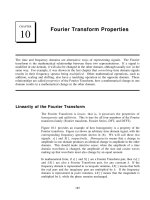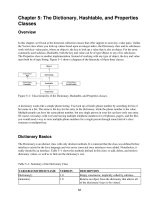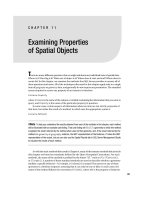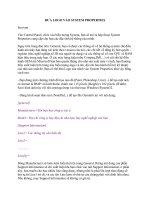mineral properties
Bạn đang xem bản rút gọn của tài liệu. Xem và tải ngay bản đầy đủ của tài liệu tại đây (1.45 MB, 33 trang )
PROPERTIES
OF MINERALS
Chapter 2, Section 1
By Rusty Sturken
Sixth Grade Science teacher
Duluth Middle School
August, 2010
What is a mineral?
• A mineral is a naturally
occurring, inorganic solid that
has a crystal structure and a
definite chemical composition
5 Characteristics that all
minerals share
1.
2.
3.
4.
5.
Naturally occurring
Inorganic
Solid
Crystal structure
Definite chemical composition
Naturally Occurring
• Naturally Occurring means that the
substance must occur in nature, it
can not be created or
manufactured by people.
Inorganic
Inorganic means that a
mineral can not come from
something that was once
living.
Solid
A Solid has a definite
volume and shape, its
particles are tightly packed
together and can not move
easily.
Crystal structure
• Crystal structure means the
particles that make a mineral
line up in a pattern that repeats
over and over again, this
pattern creates a crystal. A
crystal has flat sides called
faces that meet at sharp edges
and corners
Crystal structure
Top left from />Top Right />Bottom Left />Bottom Right />3uOjrscEi3qsGmQpQ4LGwERlyB-Iww&t=1&usg=__7mdDC9sp-_A5hsegmp5Tp6eDizY=
Definite chemical
composition
Definite chemical composition
means that a mineral always
contains certain elements in
definite, or exact, proportions
Almost all minerals are compounds in which two
or more elements are combined so they no longer
have their distinct properties.
Some elements occur in a pure form in nature
and are considered minerals (almost all are metals
such as copper, silver, and gold)
Which 2 of the following are not
minerals? Why?
•
•
•
•
•
•
•
Talc
Flourite
Galena
Crude Oil
Quartz
Pyrite
Coal
Which 2 of the following are not
minerals? Why?
•
•
•
•
Talc
Flourite
Galena
Crude Oil- liquid (not solid) and organic
(made of plant and animal remains)
• Quartz
• Pyrite
• Coal- Organic (made of plant and animal
remains)
Identifying Minerals
• Each mineral has its own specific properties that can
be used to identify it, this is due to the fact that each
mineral has its own unique make-up.
• Hardness- Mohs Hardness Scale
• Color
• Streak
• Luster
• Density
• Crystal Systems
• Cleavage and Fracture
• Special Properties
– Flourescence
-- Double Refraction
Identifying Minerals
• Each mineral has its own specific
properties that can be used to
identify it.
Hardness- Mohs Hardness Scale
• Hardness (how hard a mineral is) is one
of the best properties that can be used
to help identify a mineral
• Mohs Hardness Scale ranks 10
minerals from softest to hardest, Talc
is softest and Diamond is hardest
Hardness- Mohs Hardness Scale
Our textbook lists Feldspar for 6
/>
Color
• The color of a mineral is a physical
property that is easy to observe.
• Color can only be used for a few
minerals that have their own specific
color
• The color of a mineral alone does not
usually give enough information to
make a definite identification. Some
minerals come in many colors
Streak
• Streak tells the color of a mineral’s
powder. To find the streak of a
mineral you rub the mineral
against an unglazed tile called a
streak plate.
Streak
Streak
Is this Gold? How do you know?
Luster
• Luster describes how a mineral reflects light
from its surface. Such as:
• Description
–
–
–
–
–
–
–
–
–
–
Glassy
Silky
Greasy
Metallic
Earthy
Waxy
Pearly
Resinous
Brilliant
Dull
Examples
Quartz
Gypsum
Talc, some Quartz
Gold, Pyrite, Galena etc
Kaolin
some Serpentine
Gypsum, some Talc
Amber
Diamond
Graphite
Density
• Density is the mass in a given
space, or mass per unit
volume. No matter how large
or small the sample of a
mineral is, its density will
remain the same.
• Density= Mass/Volume D=M/V
Density
• Mass is the amount of matter in an
object or material and is measured
in milligrams, grams, or kilograms
• Volume is the amount of space that
an object or material fills and is
measured in milliliters, liters, or
kiloliters (rarely in kiloliters)
• Density is mass divided by volume
so density is typically measured in
grams per milliliter
Density
• The density of liquid water is
1.0 grams per milliliter (1.0
g/ml)
–Anything more dense than 1.0
g/ml sinks in water
–Anything less dense than 1.0
g/ml floats in water
Density
LOW DENSITY
HIGH DENSITY
Left image from />Right image from />
Crystal Systems
• The crystals of minerals grow atom
by atom to create that mineral’s
crystal system.
• Geologists classify crystal
systems into six groups based on
the number and angles of the
crystal faces









